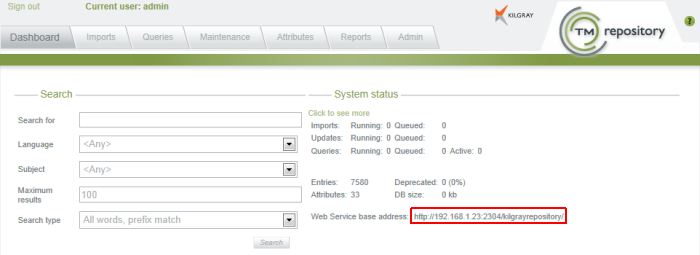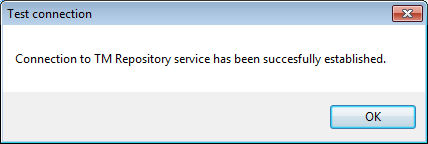|
If you use both a memoQ server and a TM Repository server, you can use the content from the TM Repository database on your memoQ server. For more information on TM Repository, see TM Repository Help on the Kilgray website. Before you can use TM Repository content in memoQ, you need to connect your memoQ server to the TM Repository server. To carry out the steps below, you need to log on as an administrator both to memoQ server and to the Web-based user interface of TM Repository. For memoQ users to access TM Repository, they need to have appropriate user accounts in the TM Repository system as well. When setting up the connection to TM Repository, you need to decide on the following: •You can use the same TM Repository user account for all your memoQ users. In this case, you need to specify a default user name and password in memoQ server. memoQ server will send this user name and password to TM Repository whenever it logs on, regardless of the particular memoQ user issuing TM Repository-related commands. •You can use the same user name and password for users on both memoQ server and TM Repository. However, in this case, the users need to have the same user name and password in memoQ server and TM Repository. The two systems do not synchronize user accounts, you need to create user accounts in the TM Repository separately. To set up the connection between memoQ server and TM Repository, follow the steps below: 1.Open the Web-based user interface of TM Repository. Log on using an administrative account. If you plan to use the default 'admin' account in the TM Repository, log on using that account. 2.If you logged on using the default 'admin' account, change the password: click Admin, then, on the Admin page, click My Profile. In the Modify user dialog, fill in the Password, Confirm password, and E-mail address boxes. Click OK. 3.If you plan to allow access for memoQ server users using their own names and passwords, you need to create user accounts for them in the TM Repository. Still in the Admin page, click New User, and fill in the details in the New user dialog. Make sure you use the same user name and password as on memoQ server. You also need to specify an e-mail address for each user. 4.Once the user accounts are created, navigate back to the Dashboard of the TM Repository. Select the contents of the Web Service base address field, and copy it to the clipboard by pressing Ctrl+C.
5.Open memoQ. On the Project ribbon tab, choose Server Administrator. The Server Administrator dialog appears. In the Connection pane, type or select the name of the memoQ server that you want to connect to TM Repository, and click Connect. 6.On the category list to the left, click TM Repository. The TM Repository pane appears. In the TM Repository pane, you need to specify the following information:
(The screenshot is filled in with information from a live system. These are not the default values.) •The address where TM Repository is available to the memoQ server. Use the address copied from the TM Repository dashboard. Change the address between http:// and :2304 if you do not prefer to use the first IP address of the TM Repository server. Note: If you have a friendly domain name for the TM Repository server such as tmrepository.yourcompany.com, it is recommended that you use the domain name instead of the IP address. •The address where users can access the TM Repository interface. This is usually a web address in this form: http://servername/TMRepository. If TM Repository was installed using default settings, this address will be correct if you just substitute the server name with the real server name, preferably with one that is accessible from the computers of all users who need access to the TM Repository. Note: This address is needed because for some actions, memoQ invokes the Web-based interface of TM Repository, and logs on the user automatically. The memoQ server needs this address to direct the user to the appropriate page. •The default user name and password: memoQ server uses this user name and password to test the connection. In addition, memoQ server uses this name and password for all connections if it is not set to integrated login. •The list of authorized users: In most cases, TM Repository is intended for use by administrators and project managers. Translators rarely need direct access. When setting up the connection, you need to list memoQ server users who have the privilege to access TM Repository as well. •Login method: You can choose from 'integrated' and 'default'. 'Integrated' means that memoQ server uses the user's own user name and password to connect to TM Repository. 'Default' means that memoQ server always sends the default user name and password. Regardless of the login method, memoQ server allows access for authorized users only. See also: For more details on the TM Repository pane of Server Administrator, see the corresponding Help topic. 7.After you fill in all these details, click Save. (Do not close the Server Administrator dialog.) Then, test the connection by clicking the Test connection link. You should receive the following message:
8.Click OK to dismiss this message box. 9.To test if memoQ can bring up the Web interface of TM Repository, click the Open TM Repository in browser link. The TM Repository logon screen should appear (possibly after a delay of up to one minute if it is accessed for the first time). 10.Return to the Server Administrator dialog, and click Close. Your memoQ server and the TM Repository server are now connected.
|


